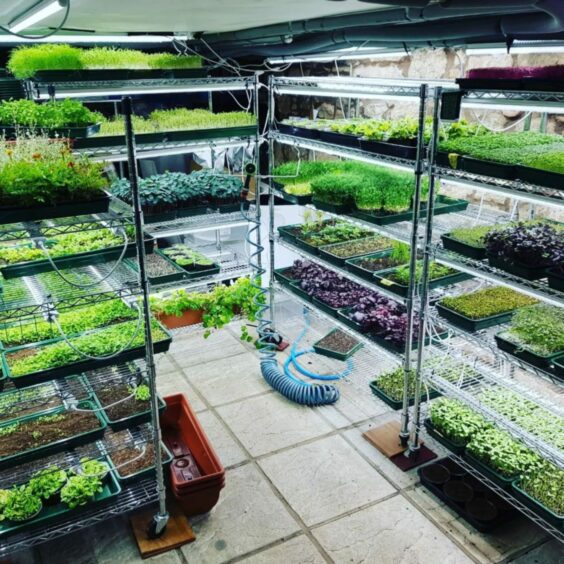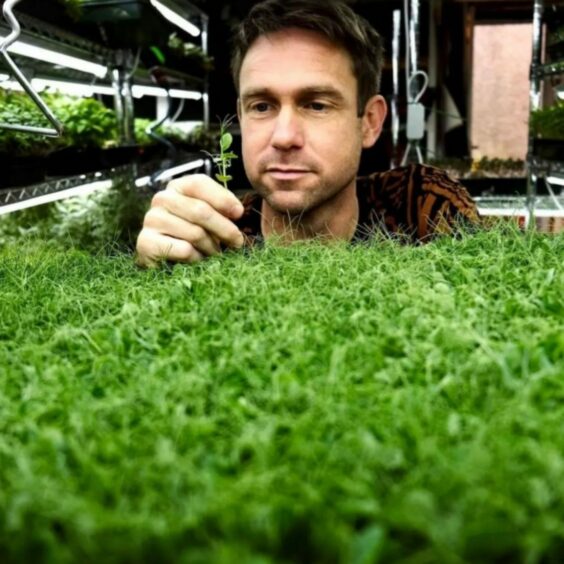Empty cabinets have grow to be as widespread as tomatoes are uncommon however, in keeping with consultants, Scotland’s depleted supermarkets expose the fragility of our meals provide chain.
Current shortages of some fruit and greens have been attributed to crop failures in Europe and Africa led to by excessive climate pushed by local weather change in addition to the influence of Brexit, labour shortages, the continued struggle in Ukraine driving inflation and a pointy improve in power costs that has left greenhouse growers struggling to show a revenue.
Because the UK imports round 46% of the meals it consumes and closely depends on each imports and its agricultural sector to feed an ever-growing inhabitants, consultants in Scotland consider vertical farming is a crucial resolution to considerations round world meals safety.
The tactic has been pioneered by the Edinburgh-based firm Clever Development Options (IGS) and scientists on the James Hutton Institute.
“When you stability imports and exports, the UK’s deficit within the commerce of fruit and greens might be decreased yearly by a minimum of £1 billion by rising issues internally with vertical farming,” mentioned Derek Stewart who directs the Superior Plant Development Centre, a £27 million flagship challenge on the James Hutton Institute.
“The argument was that vertical farming may solely develop salad or inexperienced crops however we’re beginning to take a look at completely different protein crops like quinoa, beans and buckwheat. The marketplace for plant-based proteins is big. To ship a high-value, high-quality product on the required scale you want one thing like vertical farming.”
Throughout the nation in warehouses, analysis services and farm buildings, growers, technicians and researchers proceed to pioneer advances in vertical farming, whereby crops develop indoors in vertically stacked layers utilizing LED lights and infrequently water-based nutrient options (hydroponics) rather than daylight and soil.
As an alternative of crop farmers being on the mercy of nature, vertical farming places management into the arms of the grower. Parts akin to gentle, temperature, humidity, air circulation, water, pH ranges and vitamins can all be managed on the contact of a button, even remotely.
This implies crops cannot solely be grown sooner and extra effectively to a persistently top quality utilizing much less house in comparison with conventional farming however can achieve this all yr spherical with out chemical compounds or pesticides.
Essential analysis on the James Hutton Institute has benefited from current investments together with £17m from the Scottish Authorities to redevelop its services at Invergowrie and additional analysis into rising sustainable barley crops and discover developments in vertical farming.
“In most crops we’ve checked out we are able to cut back manufacturing time by 30-40% so you possibly can develop a lot sooner and, by manipulating the sunshine or including vitamins, we are able to make crops extra nutritious akin to being greater in vitamin C or zinc, and alter and improve the style, density and color,” mentioned Stewart.
“Sure crops can frequently bear fruit. IGS grew chillies for about 18 months, frequently fruiting on the crop, which is unprecedented, so the worth you’re getting out of that crop is astronomical. Growers are seeing the benefit. By controlling the atmosphere, it offers them a crop twelve months a yr. Local weather change is inflicting excessive climate variations that almost all vegetation can’t deal with however on a vertical farm you’re assured a high-quality crop whatever the climate and circumstances exterior.”
At a time when farmers face rising prices, labour shortages, hen flu and post-Brexit modifications to help funds, vertical farming may support quite than change the struggling sector. Stewart added: “Farmers are businessmen so the primary issues they ask after they see the vertical farms are, ‘How a lot does it price and the way do I get one?’”

IGS, which designs, builds and exports vertical farms from six to 12 metres excessive around the globe, has had 350 commissions throughout 4 continents and has grown from a workers of 20 pre-pandemic to 250 now. Its towers can develop 200 completely different sorts of edible produce together with potatoes, carrots, radish, peppers, melon, strawberries, tomatoes, brassicas, broccoli and pak choi.
“We’re on the forefront of this and rising exponentially with probably the most refined machine of its sort on the planet,” mentioned the corporate’s CEO, David Farquhar, who has seen public attitudes in direction of produce grown in vertical farms shift in recent times.
“I spoke at a shopper present final October to seek out out what questions the general public would ask, like, ‘Is that this Frankenstein half two?’ however general folks mentioned it gave them hope that it is likely to be a solution to sustainably rising an rising quantity of meals.”
Current challenges impacting conventional farming strategies akin to lowering soil well being, floods, droughts and the influence of plant ailments and pests don’t apply to vertical farming.
“The quantity of arable land that’s nonetheless productive is lowering yearly and greenhouse operations have been massively challenged by rising fuel costs,” mentioned Farquhar.
“Vertical farms can be utilized in very arid areas. We use 250 occasions much less water than a discipline. To develop a kilo of lettuce in a discipline you want 250 litres, about 25 litres in a greenhouse, however only one on a vertical farm.”
The tactic additionally requires much less house so is ideally suited to city and industrial environments. “The ratio of house required is usually 10,000 to 1 so what we develop in a 42 sq. metre footprint would require 4 hectares in a discipline. It may well additionally cut back meals miles because it means that you can develop, say, blueberries in Dundee in winter quite than flying them in from Peru.”
Farquhar added: “By way of world meals provide, vertical farming is complementary. It’s not going to compete with conventional farmers and growers however hopefully grow to be a part of their toolkit, like a tractor or mix harvester. As different types of rising are more and more challenged, and as our inhabitants heads in direction of 10 billion, we are going to want each technique we are able to lay our arms on.”

Vertical farming isn’t with out its drawbacks, together with big start-up and really excessive power prices. With some meals producers additionally reportedly reducing again on their use of greenhouses because of rising power course of, and lots of greenhouse growers going through closure, the Hutton Institute and IGS are additionally wanting into powering vertical farms with renewable power.
“When you use renewable power, it’s by far probably the most sustainable and productive system you will get,” mentioned Stewart. Plans for a £2million renewable energy-powered vertical farm on Orkney have additionally lately been green-lit.
Whereas vertical farming is large enterprise, it’s also rising on a smaller scale throughout Scotland to provide contemporary and bountiful produce nearer to house.
Daniel Oliveira is among the few business vertical farm growers in Scotland. On his household farm in Duffus close to Elgin, he grows stacked trays of nutrient-dense microgreens with a small 21 sq. metre vertical farm in a cellar.
His firm, Rising Roots, grows and sells a wide range of microgreens to cooks and different prospects.
“I realized tips on how to do it on YouTube by following completely different fashions and copying concepts and put them into observe in an outdated cellar in one among our farm buildings,” mentioned Oliveira. “You possibly can management every thing like filtering the water, including vitamins and utilizing dehumidifiers and air conditioners to purify the air which creates a greater product than if grown exterior.”

Microgreens are the seedlings, or first leaves, of edible greens, flowers and herbs harvested inside the first two weeks of progress. Filled with flavour and vitamin, they’re a preferred addition to salads and make delicate but scrumptious garnishes in eating places.
“We develop round 20 completely different varieties together with pea shoots, sunflower seeds, broccoli and radishes and may produce as much as 15 kilos of microgreens per week,” added Oliveira.
In a bid to make his enterprise cheaper and sustainable, Oliveira lately crowdfunded sufficient seed cash to increase his enterprise by changing a disused farm constructing onsite. He additionally hopes to finally use wind turbine power to assist energy his enterprise.
Oliveira added: “I wish to carve a path for the way forward for sustainable farming and spotlight an method to rising that’s kinder to the atmosphere, reduces carbon, promotes a round economic system, limits carbon miles and in the end gives an optimum well being meals.”
10,000 bushes develop in an space the scale of a snooker desk
Vertical farming isn’t simply remodeling the best way we develop meals. It can be used to develop botanicals and vegetation to be used in skincare merchandise and fragrance, in addition to prescription drugs and even bushes and gin.
The James Hutton Institute has been experimenting with how vertical farms can grow to be “inexperienced factories”.
“You can begin rising the subsequent era of prescription drugs in crops,” mentioned Derek Stewart of the institute’s Superior Plant Development Centre. “There’s an organization in Canada rising Covid vaccines in vegetation utilizing vertical farming.
“Vaccines and prescription drugs are made utilizing nice fermentation vats that run on big quantities of power. We’re vegetation as a inexperienced manufacturing unit; an enormous set of chemical reactions we are able to use to provide prescription drugs.
“You possibly can take the gene and put it into the plant, which converts that gene right into a protein or chemical to a really top quality, however very cheaply. When harvested, it comes out at an extremely excessive purification stage so doesn’t want a lot of a tidy up earlier than it’s tableted or pelletised right into a therapy.”
IGS has additionally been working with Forestry and Land Scotland to hurry up the method of reforestation by rising tree saplings in vertical farms.
“They grew about six occasions sooner than in a greenhouse at two-thirds the associated fee and our wastage fee on early bushes rising out is lower than 10% a lot decrease in comparison with business forestry,” mentioned David Farquhar of IGS.
“On one progress tray, which is the scale of a snooker desk, we are able to develop 10,000 early-stage bushes. There are 50 trays in a 9 metre-high tower which suggests we are able to develop half one million bushes within the house of 42 sq. meters.”
Stewart added: “Folks that wish to re-wild areas will look to vertical farming methods to provide these varieties of vegetation.”
